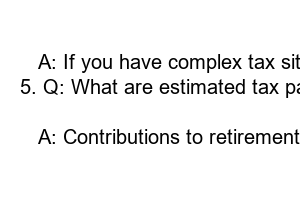연말정산 하는법
Title: Year-End Tax Settlement Made Easy: A Complete Guide
Introduction:
As the year comes to a close, it’s time to start thinking about year-end tax settlement. Preparing your taxes can be overwhelming, but with a little organization and understanding, you can breeze through the process. In this blog post, we will guide you through the essential steps to ensure a smooth tax settlement to maximize your deductions and minimize stress.
1. Gather Your Documents:
To begin the year-end tax settlement process, gather all the required documents such as W-2 forms, receipts, and financial statements. *Organizing these documents beforehand* will save you time and prevent any potential errors.
2. Review Changes to Tax Laws:
Stay informed about any changes to tax laws that could impact your return. *Familiarize yourself with recent tax reforms* and adjustments to ensure accurate reporting.
3. Consider Tax Deductions and Credits:
Identify potential tax deductions and credits you may qualify for. *Keep track of eligible expenses* such as medical bills, education costs, or home office expenses to increase your chances of a larger refund or reduced tax liability.
4. File Electronically:
Opt for electronic filing instead of paper filing. *Electronic filing is faster, more accurate,* and ensures a quicker refund, if applicable. Make use of reputable tax software that streamlines the process and checks for any errors.
5. Plan for Retirement Contributions:
Make any necessary adjustments to your retirement plan contributions before the year-end. *Contributions to retirement accounts reduce your taxable income* while contributing to your retirement fund.
6. Consult a Tax Professional:
If you’re unsure or have complex tax situations, it is wise to consult with a tax professional. *Tax professionals are well-versed* in the ever-changing tax laws and can provide advice tailored to your specific circumstances.
7. Estimated Tax Payments:
If you anticipate owing more than $1,000 in taxes, consider making estimated tax payments to avoid penalties. This can be particularly important if you are self-employed or receive income from other sources.
Summary:
Year-end tax settlement can be daunting, but with a little preparation and knowledge, it can become a smoother process. By gathering all the necessary documents, staying informed about tax laws, taking advantage of deductions and credits, and utilizing electronic filing, you can make your tax settlement less stressful. Remember to review your retirement contributions, consult a professional if needed, and consider making estimated tax payments to avoid any unexpected penalties. With these steps, you’ll be well on your way to successfully settling your year-end taxes.
Frequently Asked Questions (FAQs):
1. Q: What documents do I need for year-end tax settlement?
A: You will need documents such as W-2 forms, receipts, and financial statements.
2. Q: How can I maximize my tax deductions?
A: Keep track of eligible expenses like medical bills, education costs, or home office expenses.
3. Q: Is electronic filing better than paper filing?
A: Yes, electronic filing is faster, more accurate, and ensures a quicker refund if applicable.
4. Q: Should I consult a tax professional?
A: If you have complex tax situations or uncertainties, it’s wise to seek advice from a tax professional.
5. Q: What are estimated tax payments?
A: Estimated tax payments are advance tax payments made to avoid penalties if you anticipate owing more than $1,000 in taxes.
6. Q: How can retirement contributions help with taxes?
A: Contributions to retirement accounts reduce your taxable income and aid in building your retirement fund.

